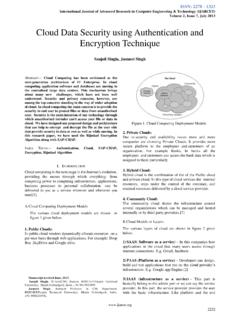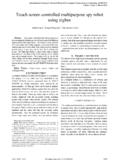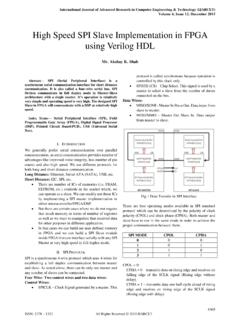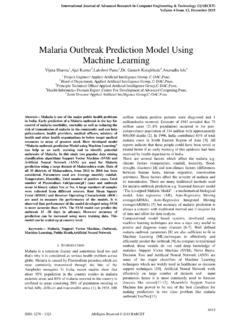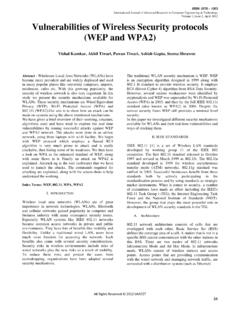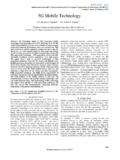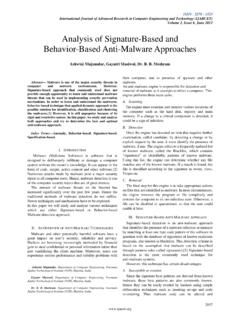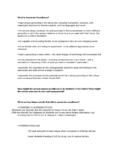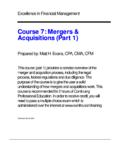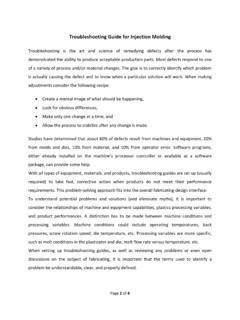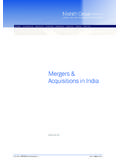Transcription of REVIEW OF REMOTE SENSING IMAGE …
1 International Journal of Advanced Research in Computer Engineering & technology (IJARCET) Volume 4 Issue 4, April 2015 1667 ISSN: 2278 1323 All Rights Reserved 2015 IJARCET REVIEW OF REMOTE SENSING IMAGE SEGMENTATION TECHNIQUES Harmanpreet Kaur Department of Electronics and Communication Amritsar College of Engineering & technology Abstract IMAGE segmentation is an important tool in IMAGE processing and can serve as an efficient front end to sophisticated algorithms and thereby simplify subsequent processing. IMAGE segmentation by region merging follows a particular order in the choice of regions. The target of segmentation is always to simplify and/or change the representation of a graphic into something that is more meaningful and simpler to analyze. IMAGE segmentation is normally used to locate objects and boundaries (lines, curves, etc.)
2 In images. To improve segmentation accuracy and the correctness, this paper proposed a Dynamic Statistical Region Merging (DSRM) algorithm to find the automatically select scale value. The purpose of this paper is to gather various segmentation techniques that can be used for the segmentation of REMOTE SENSING images (RSI). The paper provides good starting for researchers to find automatically select scale value using the combination of DSRM and fuzzy logic. Keywords IMAGE segmentation, Multi-scale segmentation, REMOTE SENSING IMAGE segmentation, Dynamic statistical region merging, Region growing. 1. Introduction IMAGE segmentation is the process of partitioning a digital IMAGE into multiple segments (sets of pixels, also known as super pixels). The target of segmentation is always to simplify and/or change the representation of a graphic into something that is more meaningful and simpler to analyze.
3 IMAGE segmentation is normally used to locate objects and boundaries (lines, curves, etc.) in images. Result of IMAGE segmentation is a couple of segments that collectively cover the entire IMAGE , or even a set of contours extracted from the IMAGE . All the pixels in a region are similar regarding some characteristic or computed property, such as color, intensity, or texture. Its performance directly determines the final consequence of some type of computer visual task. Up to now, you will find over one thousand types of segmentation approaches, which may be broadly classified as the Global-based (GB) and the Local-based (LB). The classical ways of the GB include Normalized-Cut, Efficient Graph-Based Method, Ratio-Cut, and Mean-shift and so on. The Watershed, Fractal Net Evolution Approach (FNEA), Statistical Region Merging (SRM), etc.
4 Are the LB methods. Recently, more and more attention has been paid on multi-scale segmentation. The multi-scale segmentation is applied widely on information extraction from RSI, change detection, classification and so on. Segmentation criteria can be arbitrarily complex and may consider global along with local criteria. A common requirement is that all regions must be connected in some sense. Multi-Scale segmentation is of two types: - (1) One-dimensional hierarchical signal segmentation. (2) IMAGE segmentation and primal sketch. Various techniques have already been proposed for IMAGE segmentation. They are categorized in line with the application, imaging modality, and other factors. The segmentation techniques are (1) Thresholding approaches (2) Region growing approaches (3) Classification-based approaches (4) Artificial neural networks.
5 The Statistical region merging (SRM) is an algorithm used for IMAGE segmentation. The algorithm can be used to judge the values within a regional span and grouped together based on the merging criteria resulting a smaller list. Some useful examples could be creating a group of generations within a population or in IMAGE processing grouping a group of neighboring pixels based on their shades that fall within a particular threshold. Using the Statistical Region Merging (SRM) for REMOTE SENSING IMAGE segmentation, the result is unsatisfactory. To improve the segmentation accuracy and the International Journal of Advanced Research in Computer Engineering & technology (IJARCET) Volume 4 Issue 4, April 2015 1668 ISSN: 2278 1323 All Rights Reserved 2015 IJARCET correctness Dynamic Statistical Region Merging (DSRM) is introduced.
6 It tries to let probably the most similar regions to be tested first. Initially, it redefines the dissimilarity based-on regions. Then, it dynamically updates the dissimilarity and adjusts the test order during the task of merging. The accuracy of the DSRM is higher than the SRM and its computational complexity is approximately linear. Furthermore, we extend the DSRM to multi-band REMOTE SENSING IMAGE and utilize it for multi-scale segmentation. The SRM may also be used for multi-scale segmentation by construct a hierarchical structure. However, the SRM has some problems on the order followed to test the merging of regions. It only uses gray difference of adjacent pixels to define the Dissimilarity, based on that your testing order is decided. The order is determined in the beginning, and doesn't change during the task of region merging.
7 This static testing order could cause incorrect merging in a few cases. Such as on blurry edge and gradual change region, the pixel difference ( Dissimilarity) is also very small. So it could be tested before some object inner pixels. Moreover, if in addition, it satisfies the merging predicate, an incorrect merging occurs. With regions growing, one object is easily merged with another over blurry edge or gradual change region, causing under-segmentation. To lessen this incorrect merging, an energetic strategy is proposed. The Dynamic Statistical Region Merging (DSRM) tries to test the most similar regions first. Initially, the Dissimilarity is redefined as the difference of the regions, to which each pixel belongs. Then, it dynamically updates the dissimilarity and adjusts the test order during the task of merging.
8 Therefore the blurry edge and the gradual change region can barely cause incorrectly merging. 2. Literature Survey Jian Yang and et al. [2] proposed an unsupervised multi-band approach for scale parameter selection in the multi-scale IMAGE segmentation process, which uses spectral angle to measure the spectral homogeneity of segments. With the increasing scale parameter, spectral homogeneity of segments decreases until they match the objects in the real world. The index of spectral homogeneity has been used to determine multiple appropriate scale parameters. The performance of the proposed method was compared to a single-band based method through qualitative visual interpretation and quantitative discrepancy measures. Both methods are applied for segmenting two images: a Quick Bird scene of an urban area within Beijing, China and a Woldview-2 scene of a suburban area in Kashiwa, Japan.
9 The proposed multi-band based segmentation scale parameter selection method outperforms the single-band based method with the better recognition for diverse land objects in different urban landscapes. Jing Liu, Peijun Li and et al. [3] proposed a novel IMAGE segmentation method for VHR multispectral images using combined spectral and morphological information. The method can be summarized as follows. First, a morphological derivative profile has been calculated from an original multispectral IMAGE and combined with the spectral bands to quantify spectral-morphological characteristics of a pixel, which are considered as a criterion of homogeneity of neighboring pixels. IMAGE segmentation was conducted using a seeded region-growing procedure, which has been based on the seed points automatically generated from the gradient IMAGE and dynamically added and the similarity between a seed pixel and its neighboring pixels in terms of spectral-morphological characteristics.
10 The obtained segmentation result was further refined by a region merging procedure to generate a final segmentation result. The proposed method has been evaluated using three VHR images of urban and suburban areas and compared with two existing segmentation methods, in terms of visual inspection, quantitative evaluation and indirect evaluation. Experimental results demonstrate that the joint use of spectral and morphological information outperformed the use of morphological information alone. Furthermore, the proposed IMAGE segmentation method performed better than existing methods. The proposed IMAGE segmentation method was well applicable to the segmentation of VHR imagery over urban and suburban areas. Zhijian Huang and et al. [4] has proposed the novel feature for REMOTE SENSING IMAGE analysis, called multi-scale relative salience (MsRS) feature.
